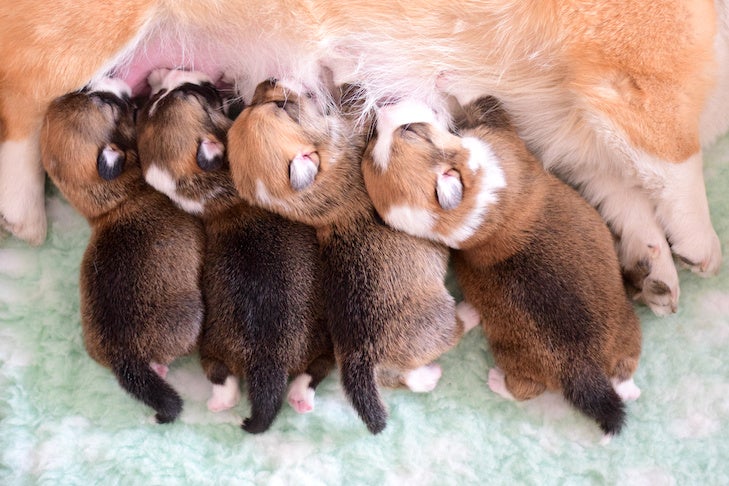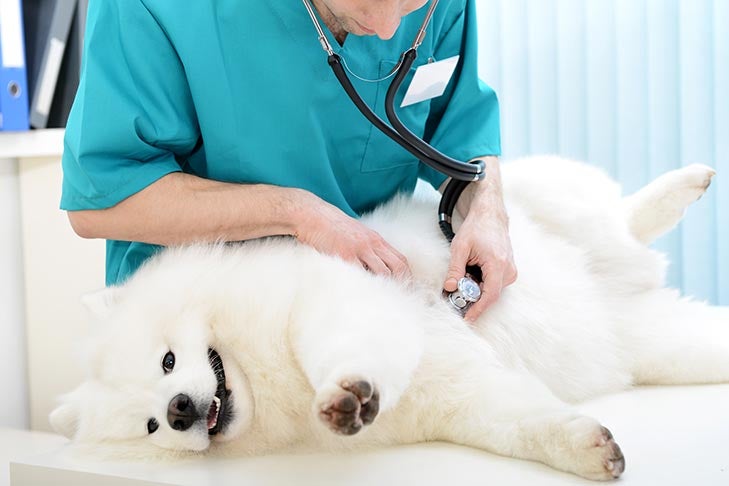- Breeding a dog is a big responsibility, and there’s a lot to learn about dog pregnancy and delivery.
- A veterinarian can conduct diagnostic tests to find out if your dog is pregnant.
- Learning the signs and timing of successful whelping will help ensure healthy puppies.

Welcoming a new litter of puppies into the world is very rewarding, but dog pregnancies can be confusing and stressful, as well as time-consuming and costly.
If you are considering breeding your dog, there is so much information that you need to know. You should be familiar with your breed’s standard and individual breed health test recommendation, as well as the responsibilities you’ll have in raising healthy well-socialized puppies. You will also need to know the signs of pregnancy in dogs and how best to care for your pregnant bitch. Here are the answers to some of your questions.
How Long Are Dogs Pregnant?
Dogs are pregnant for approximately 62-64 days, or about two months, although the Merck Veterinary Manual says, “predicting the timing of a delivery can be difficult because the date of breeding does not always match the date of conception. The length of pregnancy can also vary with breed and litter size.”
Dr. Jerry Klein, AKC chief veterinary officer, explains that during the first month of pregnancy, the fertilized eggs travel to the uterine horn, where they embed themselves in the lining at about 15-18 days. Fetal growth is rapid during early pregnancy, and these swellings double in diameter every 7 days, according to Merck.
By the end of the first month, a veterinarian can detect a fetal heartbeat, and the development speeds up into the second month as the embryos develop into recognizable puppies. At the end of the second month and the start of the third, the puppies are ready to be born.
How to Tell if Your Dog Is Pregnant
Dogs don’t have the option of picking up a pregnancy test kit from the pharmacy, which means we have to rely on other methods to determine if a dog is pregnant. The most accurate way to tell if a dog is pregnant is through diagnostic testing.
- Palpation If you know the date your dog was bred, your veterinarian can perform abdominal palpation starting at approximately the 28-30-day mark. At this stage in the pregnancy, the puppies feel like little golf balls or grapes depending on the size of the dog. These “balls” are fluid-filled sacks surrounding the fetus. Abdominal palpation should not be attempted without the assistance of a veterinarian, as it could damage the pups. The sacks lose their distinct shape after one month, so the timing of this test is important.
- Ultrasound Alternatively, your veterinarian can do an ultrasound between 25 and 35 days of gestation. An ultrasound can usually detect fetal heartbeats, giving you an estimate of the number of puppies the bitch is carrying. The puppies’ heartbeats are 2-to-3 times faster than the mother’s.
- Hormone test At about 25-to-30 days of gestation, your veterinarian can perform a blood test to measure the dog’s hormone levels to see if she is producing the hormone relaxin. Relaxin is only produced during pregnancy, making the test relatively accurate.
- X-ray X-rays are one of the most effective ways to determine if a bitch is pregnant. However, this is best done at 55 days or more, as the puppies’ skeletal systems don’t show up on an x-ray until then. An x-ray at this time allows you to get an accurate count of the number of puppies, which will prepare you to know when your dog is finished delivering.

Signs of Dog Pregnancy
Diagnostic testing isn’t the only way to determine whether a dog is pregnant, although it is the most accurate. There are signs of dog pregnancy you can watch for, including:
- Increase in appetite
- Weight gain
- Increase in nipple size
- Swollen belly
- Tires more easily
- Nesting behavior
- More affectionate
- Irritability
In addition, some dogs may vomit and have a decrease in appetite for a few days in the first few weeks due to changes in hormones. “Some dogs will exhibit these sighs, but may actually be experiencing a false pregnancy,” says Dr. Klein. “There are also other conditions that can cause changes in appetite, weight gain, and a swollen abdomen. To rule out a more serious condition, take your dog to the veterinarian for a checkup.”
Caring for a Pregnant Dog
Once you have determined that your dog is pregnant, there are some steps you should take to make sure she stays healthy throughout her pregnancy.
Proper Nutrition
One of the most important things you can do for your pregnant bitch is make sure she receives proper nutrition. If your dog is already on a good quality dog food and is at a healthy weight, you won’t have to make any changes to her diet for the first two-thirds of her pregnancy unless otherwise directed by your veterinarian. In fact increasing the amount of food at this stage can be harmful.
As her weight increases in the last weeks of her pregnancy, veterinarians recommend increasing her food intake gradually, until she consumes 35-to-50 percent more than usual. Increase her intake slowly and feed her small, frequent meals, as large meals can cause discomfort.
Exercise
If you’re trying to breed your dog, some veterinarians believe that limiting strenuous exercise during the first two weeks of gestation will enhance the implantation of the embryos. After that, normal exercise is fine until your dog’s belly is enlarged. “During her last trimester, the best exercise for your dog should not be overly strenuous. Shorter and possibly more frequent walks will be more beneficial for the mother to be as she needs her energy to carry the pups and give them nutrition,” suggests Dr. Klein.

Visits to the Vet
Before you breed your dog, take her to the vet for a prenatal checkup. She should be up-to-date on vaccinations. Your vet will probably recommend either a fecal exam to check for intestinal parasites or just have your dog de-wormed with an appropriate medication suited for your dog prior to mating.
It is now thought that de-worming the pregnant dam with an appropriate de-wormer (Fenbendazole) starting on her third trimester (about day 40 of gestation) and continuing under about 14 days post whelping significantly decreases the amount of roundworm and hookworms in newborn puppies, allowing them to grow and thrive to their utmost.
You should also ask your veterinarian what to do in the event of an emergency near the time of expected labor and set up a plan with your family and pet sitter.
Regular veterinary visits can help your dog stay healthy during pregnancy.
When the veterinarian confirms your dog’s pregnancy, they will also examine the dog for any mechanical or anatomical concerns your dog may have that could prevent them from having a normal whelped litter.
This is a good time to discuss planning on whether a normal birth or cesarean may need to be considered and scheduled in advance. If during the exam your veterinarian determines that your dog is already pregnant, and if the pregnancy is an accident, this is also a good time to discuss taking precautions in the future, such as spaying, to prevent any more surprise litters.
Preparing for Puppies
As the end of your dog’s pregnancy approaches, you’ll notice a significant enlargement of her breasts and nipples, and might even detect some milky fluid as the milk glands develop and enlarge. Her abdomen will increase in size and may sway a little as she walks. At the very end of the pregnancy, you might even be able to see or feel the puppies moving around inside the mother.
By this time, you want to prepare yourself and your dog for whelping, or puppy birthing. The best way to do this is to set up a whelping box. Whelping boxes offer a safe, warm, draft-free, easily cleaned location for your dog to have her puppies. There are whelping boxes made that can be purchased or you can even use a small children’s plastic swimming pool. The whelping box should be easy for the mother, but not the puppies, to get in and out of. Your dog may prefer to have it in a quiet area of the house but in an area that you can have easy access.
Once you have purchased or built your whelping box, take some time to get your dog accustomed to it. If you don’t introduce her to the whelping box beforehand, she might decide to deliver someplace else—like your closet.
If this is your first time breeding your dog, talk to your veterinarian about your role during labor, and read and learn what you need to know. Unless you plan to have an experienced breeder on hand, you will need to be prepared to step in when necessary during the whelping process. It’s always a good idea to have another person there with you to help keep the puppies warm or to assist if you need help.

Whelping Supply Checklist:
- Lots of newspaper to line the whelping box during delivery for easy cleanup and garbage bags
- Non-skid bath mats for bedding after whelping is done
- Dry, clean towels to clean the puppies
- Paper towels to help with clean up
- Thermometer to check your dog’s temperature before whelping
- Clean, sterilized scissors to cut the umbilical cords
- Unwaxed dental floss to tie off the umbilical cords
- Iodine to clean the puppies’ abdomens after the cord is cut and dab on the end of the cut umbilical cord
- Heat lamp set high above the box on one corner only to allow the puppies to crawl to a cooler spot in a box or hot water bottle to keep the puppies warm (be careful it isn’t too hot).
- Bulb syringe to clean puppies’ nose and mouth
- A baby scale in ounces
- Honey or light corn syrup
- Veterinarian’s phone number and the number of a nearby emergency clinic
Whelping
When your pregnant dog’s time approaches, watch out for the warning signs of labor. Pregnant mothers may stop eating a few days before whelping and may also start trying to build a “nest” — hopefully in the whelping box.
Many pregnant dogs close to delivery start to pant heavily. A drop in rectal temperature usually precedes delivery by about 8-to-24 hours from a normal temperature (100-to-102.5 degrees Fahrenheit) to 99 degrees or even lower. Many bitches ready to whelp may not eat or eat very little.
Abdominal contractions may begin slowly and gain strength and frequency – sometimes they’re strongest for the first delivery accompanied by straining and moaning. You may see the water sac come out when there’s a puppy in the birth canal, and within one hour the first puppy should be delivered.
Each puppy is born enclosed in its placental membrane and in each case, the mother licks the puppy vigorously and tears this membrane off, sometimes eating it. If she does not remove it, you will have to do it, as puppies cannot survive for more than a few minutes before their supply of oxygen runs out. You may need to rub the puppy with a clean towel until you hear him cry.
The bitch should also sever the umbilical cord as she cleans her pups. If she does not, it is up to you to snip the cord and tie it off about one inch from the belly with some unwaxed dental floss. You should wipe the abdomen of all of the puppies with iodine to prevent infection.

Some dogs deliver their puppies one right after another, but others may deliver a few puppies, and then rest before delivering more. If there’s a break of more than a two hours, you’ll want to call your veterinarian. You must also keep track of the number of placentas. A retained placenta can cause problems for the mother. Generally, the entire duration in hours of a normal whelping is about equal to the number of puppies in utero. So, a litter of 6 should normally take about 6 hours total.
Don’t forget to offer the mother water to drink and to take her outside to relieve herself if she is in the middle of having a large litter. She’ll often need to urinate. Bring along extra towels and don’t leave her unsupervised as sometimes they can pass a puppy while they are outside! During this time, the puppies should be kept warm in their whelping box with a light towel over them to prevent them from becoming chilled.
All of the puppies should be placed along the mother’s belly, and you should watch to be sure she lets them all nurse within a few hours. Keep an eye on the pups to make sure they are all breathing normally and nursing.
Possible Dog Labor Complications
Sometimes during delivery, things go wrong. If you experience any of these signs, call your veterinarian:
- Your dog’s rectal temperature dropped more than 24 hours ago and labor isn’t starting.
- The mother is exhibiting symptoms of severe discomfort, or if she doesn’t deliver the first puppy 2 hours after contractions begin especially if she has passed green discharge.
- More than 2 hours pass in between the delivery of puppies, or your dog experiences strong contractions for an hour without a birth or if the mother seems exhausted.
- Trembling, collapsing, or shivering are warning signs of serious complications that could put both the bitch and the puppies at risk.
- It’s normal for dogs to deliver a dark green or bloody fluid after the first puppy, but if this happens before the first puppy, call the vet.
- Your dog shows no signs of whelping 64 days after her last mating.
- All of the placentas aren’t delivered.
- Puppies aren’t nursing.
Pregnancy can be a stressful time for dogs and owners, but it doesn’t have to be. The more you know about dog pregnancy ahead of time, the better prepared you will be to care for your dog. For more information about dog pregnancy, consult your veterinarian.
And remember, your responsibilities have only just begun. Raising newborn puppies – assuring they are healthy, well socialized, and placed in loving forever homes – is a big, important job.

